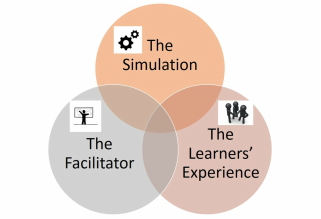"Teaching is more than imparting knowledge, it is inspiring change. Learning is more than absorbing facts, it is acquiring understanding." William Arthur Ward Get the Most from Engaging Learning Experiences A good friend says she LOVES Venn Diagrams. Especially when they work. I agree. Here's a Venn that works to expand the common view of experiential learning programs -- simulations, cases, and the like. We need to include three channels of learning to maximize the learning impact. Without them, you may be leaving some value on the table. In each of our business simulation programs, we work to leverage learning from these three areas: 1. The simulation This is the primary and most visible channel. Usually, the simulation is scrutinized quite thoroughly to determine if the messages, the inter-relationships, and the overall design meet the needs of the intended audience. Often, this is the ONLY factor that is considered. Yet, the simulation must be relatable to be meaningful. 2. The facilitator Your facilitator preparations are essential. This person can skillfully weave in the learning points most relevant to the target audience. Also, this person can bring real-world examples and cases into the discussions to extend the learning beyond the simulation exercise. Beyond that, the facilitator can offer in-depth know-how on topics like finance, marketing, decision making, or strategy. This expert can be an essential link between the simulation and the real world. 3. The learners' experience Often overlooked, the learners' experience in the simulation is another vital learning channel. How each learner responds to the challenge is tremendously valuable. Consider how often each learner needs to correct their course, reflect on their behavior, provide feedback to team members, and deal with the ambiguities of decision making. These activities are also powerful channels for learning. Recently, a client decided to get the most out of the learners' experience. She decided to engage leadership development mentors in the session, in the role of observer/coach. Each mentor joined a team in the simulation and simply observed behaviors, listened to discussions, and watched them work. In consultation with the leadership competency model, the mentor could provide specific observational feedback to the team, and tot he individual learners, in between simulation rounds. There are indeed three channels for learning in simulations. Leverage all three and you'll see tremendous impact. Good luck!
0 Comments
|
"The views expressed here do not necessarily represent the unanimous views of all parts of my mind."
- Malcolm McMahon AuthorDan Topf, CPT is Sr. Vice President at MDI, Inc. Business Learning by Dan: Primers for TrainersPDF versions of short articles on how to integrate business acumen into all training and development:
The Income Statement Cash Flow Price and Volume The Circulation of Capital The Cost of Capital Market Differentiation Industry-specific: Financial Services -- Life Insurance/Annuities Retailing Archives
January 2021
|


 RSS Feed
RSS Feed